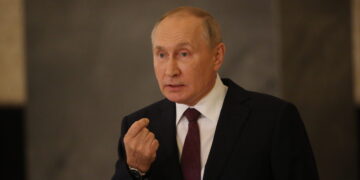
The results of a poll conducted by Harris for The Guardian are driving Biden supporters crazy. After all, “Bidenomics” is working: inflation is down, job creation is up, so where’s the beef?
The exclusive Harris poll was clear: “55% believe the economy is shrinking, and 56% think the US is experiencing a recession.”
The Guardian, one of the Biden vanguard media sycophants, says that the pollsters got it wrong: “Many Americans put the blame on Biden for the state of the economy, with 58% of those polled saying the economy is worsening due to mismanagement from the present administration.”
But how can this be? Three-quarters of those polled think that inflation is increasing. “In reality,” wrote The Guardian, “the rate of inflation has fallen sharply from its post-COVID peak of 9.1% and has been fluctuating between 3% and 4% for a year.” It added:
There’s a stubborn gap between the reality represented in the data … and the emotional reality that underlies how Americans feel about the economy. In the poll, 55% think the economy is only getting worse.
And that “stubborn gap” is a “troubling sign for [the] president’s re-election bid,” mourned The Guardian. It reflects the “gap” between what the consumer faces everyday at the grocery store and the gas pump, and what writers at The Guardian wish were true. It admitted:
Americans are clearly still reeling from price increases [currency destruction]. In the poll, 70% of Americans said their biggest economic concern was the cost of living.… 68% said that inflation was top of mind.
That’s the problem. Biden and The Guardian can complain about that “stubborn gap” but, as Harris Poll’s CEO John Gerzema expressed it: Americans are basically saying, “Economists may say things are getting better, but we’re not feeling it where I live.”
What’s the real state of economic affairs? First, we’re not in a recession. At least not yet. The common rule of thumb is two consecutive quarters of negative GDP growth. Or, put another way, two consecutive quarters where the economy’s output has shrunk.
But it’s getting closer. GDP in the third quarter of last year (on an annual basis) was a healthy five percent. In the fourth quarter GDP dropped to 3.4 percent, and in the first quarter of this year, it dropped further, to a paltry annual rate of just 1.6 percent.
Consumers “feeling it” told the University of Michigan last week that their “sentiment” dropped 13 percentage points in the last month, along with their perception of current conditions and their future expectations. The analysts wrote:
Consumer sentiment retreated about 13% this May following three consecutive months of very little change. This … decline is statistically significant and brings sentiment to its lowest reading in about six months….
[Consumers] expressed worries that inflation, unemployment and interest rates may all be moving in an unfavorable direction in the year ahead.
Biden’s approval rating on the economy continues to fall, with Biden-friendly CNN reporting that, as of May 20, just 38 percent of those it polled approve of his job performance, compared to 57 percent of them disapproving of it.
Why the disconnect? According to Gary Galles, a professor of economics at Pepperdine University who espouses commonsense economic theory, the reports on unemployment from the government are wide of the mark. He notes that there is a seven-percentage-point difference between the official employment rate and the rate implied by the household unemployment survey. He notes further that any perceived growth in the economy is being driven by illegals, while the “reduction of hours worked by full-time workers and the shift from full-time to part-time work has resulted in less labor services rendered even when official employment increases.”
In addition, he noted, more than half the jobs created last month were government jobs, explaining that “government spending doesn’t really create jobs,” but merely moves them out of the private sector, where real growth takes place, and into the public sector, which lives off the largesse and taxes generated by those remaining in the private sector.
Galles expressed it this way:
Peaceful wealth creation arises from voluntary agreements among people, but the primary activity of the regulatory state is … to interfere with … productive jobs, undermining social coordination and destroying wealth.
According to The Wall Street Journal, the best measure of how well the economy is doing is by measuring consumers’ “net worth” — financial assets held, along with real property, deducting any debts they might have. Using that measure, household net worth during the Trump administration grew by 16 percent. But the Biden administration’s anti-business agenda has caused the growth in consumers’ net worth to flatline: no growth or improvement since Biden’s inauguration in January 2021.
With the prices of gasoline up 48 percent, electricity up 28 percent, pet food up 24 percent, and eating out up 21 percent, it’s no wonder that consumers aren’t “feeling it” — despite The Guardian’s wish that they would.
Related article:
Shop For Night Vision | See more…
Shop For Survival Gear | See more…
-
Sale!

Tactical Camo Nylon Body Armor Hunting Vest With Pouch
Original price was: $49.99.$39.99Current price is: $39.99. Select options This product has multiple variants. The options may be chosen on the product page -
Sale!

Quick Slow Release Paramedic Survival Emergency Tourniquet Buckle
Original price was: $14.99.$7.99Current price is: $7.99. Add to cart

































 Reaction & Commentary
Reaction & Commentary


















